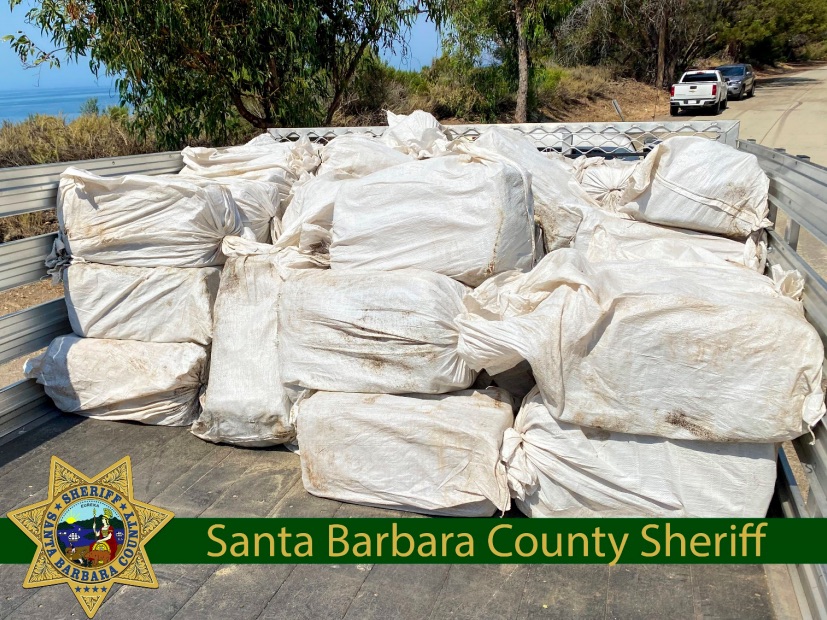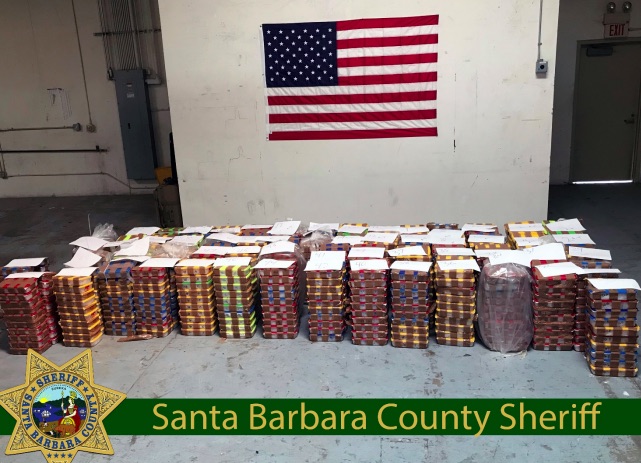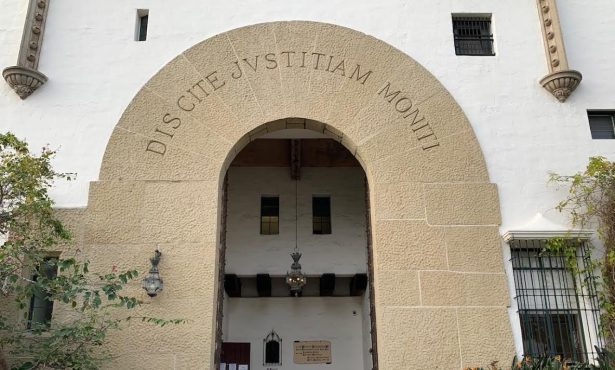The Complicated Reality of Santa Barbara’s Biggest Ever Drug Bust
Five Fishermen from Sinaloa Smuggled 1.5 Tons of Methamphetamine into the County. Was It by Choice or by Force?

In the early-morning hours of August 19, 2020, as the rest of Santa Barbara slept, a platoon of law enforcement officers lay wide awake in the thick chaparral above Arroyo Quemada Beach. The team, led by Detective Christopher MacAuley with the Sheriff’s Office, included more than two dozen deputies accompanied by FBI and Homeland Security agents.
They had received intelligence that a panga boat loaded with drugs was powering its way up California toward the remote stretch of coastline between El Capitán and Refugio state beaches. At the same time, a small fleet of SUVs and a minivan — carrying 29 people, known as a “load crew” — was driving from Riverside County to meet it.
At around 3 a.m., the load crew parked along an Arroyo Quemada frontage road and, under the darkness of the new moon that night, quietly crept under nearby trees and brush to wait for the panga. They came so close to some of the officers that they almost stepped on them.
Soon after, the boat pulled up, and five fishermen from the small town of Altata, Mexico, jumped out. They had traveled across 1,300 miles of open ocean, carrying 58 large white bales that belonged to the Sinaloa Cartel. They would later tell authorities that armed mafiosos had threatened their wives and children and forced them to make the trip north. One of them had already lost a family member to the cartel.
The journey lasted 10 days, during which the men took turns sleeping, steering, and keeping the three outboard motors fueled. They ate canned food and defecated in plastic bags that were thrown overboard.
Once the boat landed, the combined crews formed a daisy chain from the panga along a footpath to the cars and started to unload the cargo. That’s when MacAuley and his team sprung the trap. They broke from their hiding places and fanned across the beach as the suspects scattered. Many were apprehended almost immediately, though a handful made a run for it and were brought down by K-9 units.
The next morning, the Santa Barbara Sheriff’s Office announced the 34 arrests and the seizure of 3,164 pounds of methamphetamine — the biggest drug bust in the county’s history, and one of the largest ever in the nation. The $10 million worth of meth was enough to provide a dose for every man, woman, and child in the United States and Mexico combined, and then some. Photos in a departmental press release showed the bindles proudly stacked in front of an American flag.


CARGO: A photo from the Sheriff’s Office press release shows the bindles of meth proudly stacked in front of an American flag. | Credit: S.B. Sheriff’s Office
“Today’s seizure of a panga boat illicitly smuggling more than a ton and a half of methamphetamine into our county and the arrest of the 34 suspects responsible for transporting and unloading its ruinous cargo was a major milestone in counter-drug operations in Santa Barbara County,” said Sheriff Bill Brown at the time, who thanked U.S. Customs and Border Protection and the Coast Guard for providing backup. “We will never know how many lives were saved from overdose or addictive misery as a result of this exceptional law enforcement action.”
For reasons unclear, the U.S. Attorney’s Office declined to prosecute the case. It was especially perplexing because Donald Trump was running for reelection at the time and the successful raid would have galvanized his cause for stricter border policies. Those with knowledge of the operation believe federal officials may have been protecting the identity of an informant embedded within the Sinaloa Cartel.
Regardless, the task of holding the suspects to account fell to our District Attorney’s Office. While the incident briefly made local headlines, the public’s attention was focused on the COVID-19 pandemic at the time, and the case quickly faded from memory. Incidentally, it was the virus that likely directed the heavy freight into the ocean and toward our shores, as many of the cartel’s regular land and air crossings were blocked by transportation shutdowns.
Nearly everyone in the load crew, except for its main driver and leader, 25-year-old Enrique Ortega out of Riverside, has since pleaded guilty to a single misdemeanor count of acting as an “accessory after the fact to the transportation of methamphetamine for sale” and received time served. Ortega was sentenced to six years behind bars.
The five Mexican nationals who made up the boat crew — Santiago Carrillo-Galvan, 53; Oswaldo Lopez-Felix, 37; Felix Mojardin, 25; Gabriel Moreno-Sepulveda, 31; and Mario Saenz-Avila, 35 — were charged with more serious felonies. With added enhancements for the volume of meth involved, they faced the possibility of spending nearly 30 years in prison if they went to trial and lost.
Defense attorneys argued in court that the felony trafficking charges against their clients should be dismissed. But without any hard evidence of a criminal kidnapping conspiracy, it was only the men’s words against those of the Sheriff’s and District Attorney’s offices.
Rather than take that chance, four out of the five agreed to plea deals this April and were also sentenced to six years. Carrillo-Galvan, the only one among them with any criminal history, will receive a 6-14 year sentence when he returns to court next month. Under California law for nonviolent drug cases, all of the defendants will serve their time in Santa Barbara County Jail, which was originally designed for only short stays but because of state prison overcrowding is now home to many long-term inmates.
Defense attorneys, by practice, are accustomed to watching the state take custody of their clients. But this case has left a particularly sour taste in the mouths of all five lawyers, who argue the men are hardly the seasoned drug runners law enforcement officials made them out to be. Instead, they insist, the group are victims of Mexico’s prolonged drug wars that often ensnare impoverished people, especially those who live on the coast and know how to work a boat.
“Fishermen are sitting ducks for the cartels,” said Carrillo-Galvan’s attorney, Melissa Fernandez, explaining the power and prevalence of the Sinaloan syndicate throughout the region cannot be overstated. “They’ll either kidnap these guys, or tell them, ‘You’re going to work for us, or we’ll rape your wife and chop her head off.’ And they do.”
After his arrest, Carrillo-Galvan told authorities he had been drinking beers on Altata’s boardwalk with friends Saenz-Avila and Moreno-Sepulveda when three masked men forced them at gunpoint into a van. They were held overnight at a house an hour away, Carrillo-Galvan said, and then brought the next morning to a panga boat packed with bales, given supplies and a satellite phone, and told to sail north until they received a call with further instructions. During their own interrogations, Saenz-Avila and Moreno-Sepulveda provided similar stories.
Mojardin and Lopez-Felix told officials they were approached by cartel members on separate occasions and strong-armed into participating, though they were allowed to leave the harbor and come back the following day. Both had spouses and toddlers at home who were threatened by name. “The coercion and threat of death is very real,” said Lopez-Felix’s attorney, Sanford Horowitz. The Altata community is small, only about 2,000 people, and it’s easy for mafiosos, or “gangsters,” to identify potential marks.
“They’re called disposable mules,” Horowitz said of the fishermen. “The cartel doesn’t care about them — they use them and throw them out.” It’s common for the cartel to keep their forced laborers in the dark, he said. That way, if they’re caught, they can’t give authorities any useful information.
Dr. Everard Meade, a professor in the School of Peace Studies at the University of San Diego and an expert on the Sinaloa Cartel, said the case reflects a complicated and often overlooked aspect of the drug wars. “It would really be false or misleading to say that most of the cartel’s workforce are voluntary actors,” he said. “When you look at the activity, most of the perpetrators are also victims. I don’t say that to excuse anyone, but that’s what you find.”
Over the last decade, Meade explained, the cartel’s business operations have become “much less patrimonial” and “more narrowly transactional.” Meaning its leaders are now looking beyond their sworn ranks to manufacture and move drugs. The effect has been “particularly brutal” on Mexico’s citizenry, he said. “U.S. law enforcement tends to make a hard-and-fast division of who are criminals and who are not,” he said. “The reality is that there are lots more shades of gray.”
Like anyone, Meade can’t fault the logic of preventing more than 3,100 pounds of meth from reaching American cities. The Arroyo Quemada delivery was on its way to a Southern California hub, and from there it would have bled across the map.
But he wonders what impact the individual sentences will have on the bigger issues at play, or the people pulling the strings. “These seizures don’t really tell you much about whether there is any progress being made against individuals or organizations,” he said.
U.S. resources would be better spent on treating and curbing America’s drug appetite, he said, rather than playing Whac-A-Mole with modern maritime smugglers. Funneling foreign aid to economic development programs could also help, Meade suggested, noting, “Piracy went away in the 1800s because there were better economic opportunities for people.”
In court, Sheriff’s Detective Christopher MacAuley, who was a narcotics investigator for the U.S. Air Force prior to joining the department, said he didn’t buy the fishermen’s claims of kidnapping. He suggested they were attempting to “play off the violence of the cartels” and pointed to inconsistencies in some of their statements.
While MacAuley had recently attended a training on cartel coercion tactics, where a kidnapping victim outlined his experience in graphic detail, MacAuley said the Santa Barbara smugglers couldn’t be trusted. “They all developed a cover story,” he said. “They stuck to the script.”
Meghan Behrens, Moreno-Sepulveda’s attorney, remains very bothered by the outcome of the case. “These guys are not cartel heavies,” she said. “They are poor, uneducated men, and that’s who we’re punishing.”
“Am I grateful all that meth isn’t on the street?” Behrens continued. “Yes, absolutely. But are we punishing the right people? No. This sentence will in no way curtail cartel activity.”
Behrens worries for the future of her client, who has a young son back home he “misses dearly.” Once his six-year sentence is up and he’s deported back to Mexico, what then? Won’t the cartel come after him for failing the mission and losing the meth? “I hope he leaves the area,” she said.
Moreover, Behrens wondered why the load crew, who willingly drove from Riverside to collect the bales, got off with misdemeanors while the boat crew, “who was forced to do something,” now sits in County Jail.
“This was simply unjust,” she declared. “I normally don’t say that, but I really feel that way.”
Carrillo-Galvan’s attorney, Melissa Fernandez, said her client will return to court June 7, where his 6- to 14-year sentence will be decided. His adult son was previously murdered by the cartel, she said, and now he’s terrified for the safety of his 9-year-old daughter.
“He’s just another disposable piece in the cartel’s drug-dealing machine,” she said. “This is really a human rights issue.”
Support the Santa Barbara Independent through a long-term or a single contribution.




You must be logged in to post a comment.